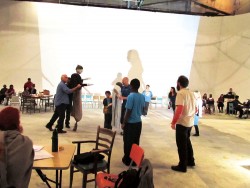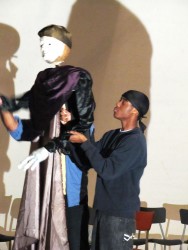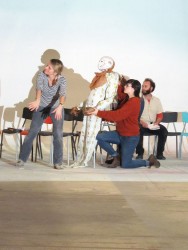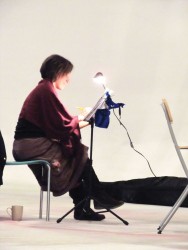 Like an Old Tale: An East Scarborough Retelling of The Winter’s Tale by William Shakespeare, (to give it its full title) is the latest chapter in Jumblies Theatre’s decade-long journey “to expand where art happens and who gets to be part of it.” Under the artistic direction of Ruth Howard, Jumblies undertakes multi-year residencies in a community, uncovering its stories and creating opportunities for the people of the community in question to turn those stories into art. “Every Jumblies community residency culminates with a large-scale production, one that melds original music, visual arts, dance, puppetry and projections into a vast theatrical realm.”
Like an Old Tale: An East Scarborough Retelling of The Winter’s Tale by William Shakespeare, (to give it its full title) is the latest chapter in Jumblies Theatre’s decade-long journey “to expand where art happens and who gets to be part of it.” Under the artistic direction of Ruth Howard, Jumblies undertakes multi-year residencies in a community, uncovering its stories and creating opportunities for the people of the community in question to turn those stories into art. “Every Jumblies community residency culminates with a large-scale production, one that melds original music, visual arts, dance, puppetry and projections into a vast theatrical realm.”
For Jumblies, unlike for some, “it’s not just a peripheral educational or community outreach programme,” says Howard. “One needs to be wholehearted and integrative about it. It takes time, forming alliances and partnerships in the community and across sectors, listening and learning, making mistakes, looking foolish, creating something glorious that awakens a shared desire for more, bringing in the best and most interesting artists available.”
“I’ve known and admired Ruth Howard’s work with Jumblies for years,” says Palmer, valiantly shaking off the jet-lag of a flight back from Wellington, New Zealand, where she is engaged in a one year composer residency, her first extended creative re-engagement with the country of her birth since 2002. “From her side, Ruth has long been wanting me to compose the music for a project. This time round, the stars aligned, the timing was right and I said yes. The conversation about this project started at the beginning of 2010 and I started to work with Jumblies in January of this year. We had a workshop of key scenes in June at the Cedar Ridge Creative Centre in Scarborough before I headed to New Zealand.”
Looking at Palmer’s musical credits and interests, it’s not hard to see why Howard would have hoped for “the stars to align” in this way. And Palmer’s description of why the project pushes her artistic buttons makes it easy to understand why it has been, and continues to be for her, a project worth incurring jet-lag for.
“My work is often anchored in different vocal expressions–opera, choral, soundscape” Palmer says. “Here I am creating a world which makes room for different cultural traditions, including Carnatic, First Nations and opera, and which allows for improvisation within a clear structure. Some moments are more installation-like, while others are clearly operatic and driven by the vocal line. There is also the powerful realm of the spoken word, performed by both professional actors and community members. When we stumbled through the outline of the piece back in the summer, I was struck by the compelling voices of young children and seniors speaking passages from Shakespeare’s The Winter’s Tale, the text which is the bedrock of the show.”
“Bedrock” is not an exaggeration. Howard’s commitment to the core text is striking. “Yes, it’s an adaptation” she says, “but the words are all Shakespeare’s. From my perspective, there’s no point doing Shakespeare without using the words.”
It took almost two years of Jumblies work on the ground in the community before Palmer came into the picture. “It was a process of reducing the text,” says Howard, “keeping my favourite passages and those that related to our thematic focus, then working with these same passages and themes in the community over a couple of years. Then I gave the reduced text to Juliet and she had freedom to pick and play within it, and then we worked back and forth with it, being quite precise about which words were cut or kept, as she composed the music. The overall script for Like An Old Tale also includes some text generated in the community — and this is, on a couple of occasions, spoken into or over Juliet’s music. These sections were conceived of by me and generated and edited collaboratively by me, our core artists and many community members.”
“One of the biggest challenges for me,” says Palmer “was composing music for amateurs. How do I create something which still feels like my own music, but can be sung by people who can’t necessarily read conventional notation? Also, how does the way music is passed along shape the result?”
Having solved that, the other half of the challenge was turning it into a score for double bass, assorted clarinets, violin, mrdangam and percussion, as well as opera singers Neema Bickersteth and Doug MacNaughton, while integrating traditional Tamil singing (Sharada K. Eswar) and First Nations elements (Rosary Spence, who has created her own original traditional-style songs) into the show’s soundscape.
“It’s a treat to work with Neema again and Doug for the first time. They are both fantastic singers and have the perfect temperament to work on a large scale, multi-community performance,” says Palmer.
The connection with soprano Neema Bickersteth is an interesting one. It goes back to Stitch, Palmer and librettist Anna Chatterton’s three woman chamber opera for urbanvessel that was one of highlights of the 2008 season.
 “A rogue brace of creative spirits cuts through the couture and sweeps us straight into a sewing sweatshop in Stitch” wrote John Terauds for the Toronto Star. “Billed as ‘an a cappella opera for three women and three sewing machines,’ it crosses so many genres as to be in a category of its own … Imagine an opera presented outside a theatre, without a stage or orchestra. It doesn’t seem like opera at all — until you realise how much a librettist, composer and three vocalists can accomplish with the simplest of means. That’s an art.”
“A rogue brace of creative spirits cuts through the couture and sweeps us straight into a sewing sweatshop in Stitch” wrote John Terauds for the Toronto Star. “Billed as ‘an a cappella opera for three women and three sewing machines,’ it crosses so many genres as to be in a category of its own … Imagine an opera presented outside a theatre, without a stage or orchestra. It doesn’t seem like opera at all — until you realise how much a librettist, composer and three vocalists can accomplish with the simplest of means. That’s an art.”
As for Douglas MacNaughton, fresh off a leading role in last month’s Toronto Masque Theatre remount of the John Beckwith/James Reaney musical Crazy to Kill at Harbourfront’s EnWave Theatre, he’s ready to go. “Go figure,” he says. “Two shows back to back providing voices for puppets. This is great.” (He’s not kidding, either. As more than one opera singer has found, being free to throw one’s disembodied voice into a space can be tremendously liberating.)
So at this point, is Palmer’s work as composer winding down? “Most of it is done,” she says “but I’m still refining some dramatic moments in response to Penny Couchie’s choreography and Varrick Grimes’ staging.”
Add to the mix the steadying hand of Erna van Daele as music director, (a Jumblies regular, and Ruth Howard fan, who in her other life also keeps the University of Waterloo Symphony Orchestra on the rails), and the show is in good hands. “UWSO is a volunteer student orchestra,” she told me, “so let’s say there are some parallels.”
 But if the bulk of the heavy lifting is over for Palmer, the big final push, so characteristic of Jumblies projects, was just beginning as of the second last week of November. That was when they moved into the decidedly unconventional venue for the show’s December 8 to 18 run, the former TVO studios at Pharmacy and Eglinton. Part of the front of the building is, fittingly, a gospel church, but the back, where the show will happen, is a massive soundstage, being used for the very first time in a live production of this kind.
But if the bulk of the heavy lifting is over for Palmer, the big final push, so characteristic of Jumblies projects, was just beginning as of the second last week of November. That was when they moved into the decidedly unconventional venue for the show’s December 8 to 18 run, the former TVO studios at Pharmacy and Eglinton. Part of the front of the building is, fittingly, a gospel church, but the back, where the show will happen, is a massive soundstage, being used for the very first time in a live production of this kind.
With the orchestra tucked back in a corner next to the curved cyclorama (which provided a surprisingly springy soundboard), the space seems improbably huge and impossible to fill, until one sees the visionary shape of the show unfolding. It consists of many circles of chairs with backdrops inspired by each of the prominent East Scarborough sites where Jumblies has been making art with community participants for the past four years.
“In our version of the world of Shakespeare’s Winter’s Tale,” explains Jumblies managing director Keith McNair, “there are many realms, all ruled over by the not-so-good King Leontes.” While the larger tale plays itself out in opera, dance, puppetry and visual imagery, within each individual realm, a story teller will be there for whomever joins that circle. Each will tell the story of the jealous overlord Leontes from the perspective of that realm, and with all the variation one might expect from eight or ten distinct realms each with its own customs.
McNair takes me to a table at the far end of the soundstage, covered with little groups of miniatures, each group made of different materials — wool, wood, paper, clay … “These are the individual storytellers’ props,” he says, “corresponding to the different community centres we worked in during the four years of the project. So each individual community storyteller will have the puppet and doll miniatures of the show’s characters, created during the four year Jumblies residency in that particular community centre.” And they are indeed all unique, all as different as the micro-environments of this most diverse of all communities in the GTA that we like to dismiss as “Scarberia.”
Although the project and show grew out of a Scarborough residency, they also include, by extension, cultural contingents from all across Toronto, as well from Nipissing First Nation (near North Bay) and from Vancouver’s Downtown Eastside. The show is a fusion of multiple cultural forms (Tamil, First Nations, contemporary Western new music and dance) and celebrates a broad spectrum of ability and experience (from novice to virtuosic) in a professionally produced production. “Within our vast cultural pool of participants,” the Jumblies press release proclaims, “our involved community members speak Arabic, Bengali, Cantonese, Czech, English, Estonian, French, Gujarati, Hindi, Italian, Malay, Mandarin, Portuguese, Punjabi, Romanian, Russian, Spanish, Tagalog, Tamil, Urdu, Vietnamese.”
“By effectively asking every audience member to help tell the story, in at least some small part, one crucial goal is to blur the traditional line between audience member, participant and artist” says Ruth Howard. “In that sense, everyone who attends becomes part of the event.”
Inspired by the people and places of East Scarborough, Like an Old Tale promises a multi-disciplinary and multicommunity spectacle performed by an intergenerational cast of over 100 local youths, adults and seniors. And if all goes ahead as planned, they will leave behind a stable community-based arts entity of some kind, a Scarborough Community Arts Guild, run by the very people Howard identified in her opening remark — local people, now four years further down the road, capable of “forming alliances and partnerships in the community and across sectors, listening and learning, making mistakes, looking foolish, creating something glorious that awakens a shared desire for more, bringing in the best and most interesting artists available.” And carrying on.
So what is next for Jumblies Theatre? And how does it relate to the dawning awareness in the official “arts sector” that arts organizations have to “move forward and meet audiences, especially the younger ones, where they are, and where they want to be?”
“I could go on and on, as this question relates to the whole raison d’etre of Jumblies Theatre” Ruth says. “We’re stepping out of specialised arts places to ‘meet’ and connect with the people of the place where we live — so that art can be accessible and meaningful for everyone — including the dedicated art-makers and the larger population experiencing and taking part in art activities and events. Everything we do is about this — it’s always been a strategy and a journey, not a fixed approach — a response to asking ‘what needs to happen here and now?’ Being out in public housing auditoriums, church basements, suburban motel suites, schools, community halls — warehouse film studios, hiring buses and taxis etc., with our limited resources, is truly unviable. But it’s worth is as a way for people to meet who wouldn’t otherwise (including artists not from the mainstream culture) and to demonstrate what’s possible socially and aesthetically (both intertwined).
“And it’s especially important, nowadays, to mention that the City of Toronto’s Cultural Service was our catalyst partner on this project (our Scarborough residency) — with shared values and vision about how art can and must expand and include all of Toronto’s people and places. They have been terrific all along and it wouldn’t have started or succeeded without them. In fact, Toronto Culture (through the museum, Montgomery’s Inn, which is now on the city chopping block), was the seminal and ongoing partner for our Etobicoke project, which is now flourishing in its seventh year as MABELLEarts.
“As for ‘young audiences’: well, we have a large, diverse and wonderful teen and young adult contingent in this show and project–in fact, they are one of the mainstays (another is a large group of Tamil seniors). We also have children as young as two and adults in their 80s. I think that the best route to involving younger people in the arts is to work in an intergenerational context — with families, cultural and geographical communities, and people of all ages–so that children and youth grow up with art being part of life and important to everyone.”




